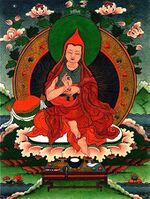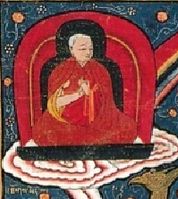Thogs med bzang po: Difference between revisions
m (1 revision imported: Import people from RTZ) |
No edit summary |
||
| (27 intermediate revisions by 4 users not shown) | |||
| Line 1: | Line 1: | ||
{{Person | {{Person | ||
|MainNamePhon=Gyalse Tokme Zangpo | |||
|SortName=Tokme Zangpo | |||
|MainNameTib=རྒྱལ་སྲས་ཐོགས་མེད་བཟང་པོ་ | |||
|MainNameWylie=rgyal sras thogs med bzang po | |||
|OtherNames=dngul chu rgyal sras thogs med bzang po; དངུལ་ཆུ་རྒྱལ་སྲས་ཐོགས་མེད་བཟང་པོ་ | |||
|PersonType=Classical Tibetan Authors | |||
|images=File:Gyalse Thokme.jpg | |||
File:Thogs med.jpg | |||
File:Tokme Zangpo.jpg | |||
|yearbirth=1295 | |||
|yeardeath=1369 | |||
|bornin=phul byung brag skya (sa skya) | |||
|BdrcLink=https://www.tbrc.org/#!rid=P1830 | |||
|TolLink=https://treasuryoflives.org/biographies/view/Gyelse-Tokme-Zangpo/3153 | |||
|tolExcerpt=Gyalse Tokme Zangpo was a Kadampa master of the fourteenth century based at Ngulchu Monastery where he sat in retreat for twenty years. He had previously served as the abbot of Bodong E for about nine years, from 1326 to 1335. Significant in the transmission of Lojong teachings, his compositions include the famous ''Thirty-seven Practices of the Bodhisattva'', one of the classics of Tibetan buddhist literature. A specialist in tantric Mahākaruṇā, he was a disciple of Butön Rinchen Drup and a teacher of Rendawa Zhönu Lodrö, and is counted as seventy-third in the Lamrim lineage. | |||
|HasDrlPage=Yes | |||
|HasLibPage=No | |||
|HasRtzPage=No | |||
|HasDnzPage=Yes | |||
|HasBnwPage=Yes | |||
|AltNamesWylie=rgyal sras thogs med bzang po; thogs med bzang po dpal; rgyal sras dngul chu thogs med; rgyal sras chos rdzong pa; dkon mchog bzang po; bzang po dpal | |||
|AltNamesTib=རྒྱལ་སྲས་ཐོགས་མེད་བཟང་པོ་; ཐོགས་མེད་བཟང་པོ་དཔལ་; རྒྱལ་སྲས་དངུལ་ཆུ་ཐོགས་མེད་; རྒྱལ་སྲས་ཆོས་རྫོང་པ་; དཀོན་མཆོག་བཟང་པོ་; བཟང་པོ་དཔལ་ | |||
|TibDateGender=Female | |||
|TibDateElement=Wood | |||
|TibDateAnimal=Sheep | |||
|TibDateRabjung=5 | |||
|ReligiousAffiliation=Kadam | |||
|TeacherOf=red mda' ba gzhon nu blo gros; 'jam dbyangs don yod rgyal mtshan | |||
|BnwShortPersonBio=Gyalse Tokme Zangpo was a Kadampa master of the fourteenth century based at Ngulchu Monastery where he sat in retreat for twenty years. He had previously served as the abbot of Bodong E for about nine years, from 1326 to 1335. Significant in the transmission of Lojong teachings, his compositions include the famous ''Thirty-seven Practices of the Bodhisattva'', one of the classics of Tibetan buddhist literature. A specialist in tantric Mahākaruṇā, he was a disciple of Butön Rinchen Drup and a teacher of Rendawa Zhönu Lodrö, and is counted as seventy-third in the Lamrim lineage. | |||
|PosBuNayDefProv=Definitive | |||
|PosBuNayDefProvNotes=Wangchuk quotes Tokme's praise of the ''Uttaratantra'', which states: "Endowed with the essence of stamens of the ultimate definitive meaning, Is this lotus grove of the teaching of the Lord Maitreya." [[Wangchuk, Tsering]], ''[[The Uttaratantra in the Land of Snows]]'', p. 60. | |||
|PosAllBuddha=Yes | |||
|PosAllBuddhaMoreNotes="Gyelsé Tokmé equates the naturally purified dharma-body with the tathāgata-essence by arguing that it is precisely because the latter exists in all beings that one can claim that the former exists in all beings also. However, unlike Dölpopa, he never explicitly says in his commentary that sentient beings have a fully enlightened buddha within." [[Wangchuk, Tsering]], ''[[The Uttaratantra in the Land of Snows]]'', p. 62. | |||
|PosWheelTurn=Third Turning | |||
|PosWheelTurnNotes=Gyelsé Tokmé emphasizes that the last-wheel teachings teach the most definitive meaning of the Buddha's thought. He states, "This meaning, which is depicted by the nine examples in this way, is the profoundest of the profound, and it is the ultimate definitive meaning." [[Wangchuk, Tsering]], ''[[The Uttaratantra in the Land of Snows]]'', p. 61. | |||
|PosEmptyLumin=Tathāgatagarbha as the Latent State of Buddhahood that is Obscured in Sentient Beings | |||
|PosEmptyLuminNotes=[[Wangchuk, Tsering]], [[The Uttaratantra in the Land of Snows]], p. 62. | |||
|IsInGyatsa=No | |||
}} | }} | ||
Latest revision as of 14:29, 12 May 2022
| PersonType | Category:Classical Tibetan Authors |
|---|---|
| MainNamePhon | Gyalse Tokme Zangpo |
| MainNameTib | རྒྱལ་སྲས་ཐོགས་མེད་བཟང་པོ་ |
| MainNameWylie | rgyal sras thogs med bzang po |
| SortName | Tokme Zangpo |
| AltNamesTib | རྒྱལ་སྲས་ཐོགས་མེད་བཟང་པོ་ · ཐོགས་མེད་བཟང་པོ་དཔལ་ · རྒྱལ་སྲས་དངུལ་ཆུ་ཐོགས་མེད་ · རྒྱལ་སྲས་ཆོས་རྫོང་པ་ · དཀོན་མཆོག་བཟང་པོ་ · བཟང་པོ་དཔལ་ |
| AltNamesWylie | rgyal sras thogs med bzang po · thogs med bzang po dpal · rgyal sras dngul chu thogs med · rgyal sras chos rdzong pa · dkon mchog bzang po · bzang po dpal |
| YearBirth | 1295 |
| YearDeath | 1369 |
| BornIn | phul byung brag skya (sa skya) |
| TibDateGender | Female |
| TibDateElement | Wood |
| TibDateAnimal | Sheep |
| TibDateRabjung | 5 |
| ReligiousAffiliation | Kadam |
| TeacherOf | red mda' ba gzhon nu blo gros · 'jam dbyangs don yod rgyal mtshan |
| BDRC | https://www.tbrc.org/#!rid=P1830 |
| Treasury of Lives | https://treasuryoflives.org/biographies/view/Gyelse-Tokme-Zangpo/3153 |
| IsInGyatsa | No |
| BnwShortPersonBio | Gyalse Tokme Zangpo was a Kadampa master of the fourteenth century based at Ngulchu Monastery where he sat in retreat for twenty years. He had previously served as the abbot of Bodong E for about nine years, from 1326 to 1335. Significant in the transmission of Lojong teachings, his compositions include the famous Thirty-seven Practices of the Bodhisattva, one of the classics of Tibetan buddhist literature. A specialist in tantric Mahākaruṇā, he was a disciple of Butön Rinchen Drup and a teacher of Rendawa Zhönu Lodrö, and is counted as seventy-third in the Lamrim lineage. |
| PosBuNayDefProv | Definitive |
| PosBuNayDefProvNotes | Wangchuk quotes Tokme's praise of the Uttaratantra, which states: "Endowed with the essence of stamens of the ultimate definitive meaning, Is this lotus grove of the teaching of the Lord Maitreya." Wangchuk, Tsering, The Uttaratantra in the Land of Snows, p. 60. |
| PosAllBuddha | Yes |
| PosAllBuddhaMoreNotes | "Gyelsé Tokmé equates the naturally purified dharma-body with the tathāgata-essence by arguing that it is precisely because the latter exists in all beings that one can claim that the former exists in all beings also. However, unlike Dölpopa, he never explicitly says in his commentary that sentient beings have a fully enlightened buddha within." Wangchuk, Tsering, The Uttaratantra in the Land of Snows, p. 62. |
| PosWheelTurn | Third Turning |
| PosWheelTurnNotes | Gyelsé Tokmé emphasizes that the last-wheel teachings teach the most definitive meaning of the Buddha's thought. He states, "This meaning, which is depicted by the nine examples in this way, is the profoundest of the profound, and it is the ultimate definitive meaning." Wangchuk, Tsering, The Uttaratantra in the Land of Snows, p. 61. |
| PosEmptyLumin | Tathāgatagarbha as the Latent State of Buddhahood that is Obscured in Sentient Beings |
| PosEmptyLuminNotes | Wangchuk, Tsering, The Uttaratantra in the Land of Snows, p. 62. |
| Other wikis |
If the page does not yet exist on the remote wiki, you can paste the tag |



